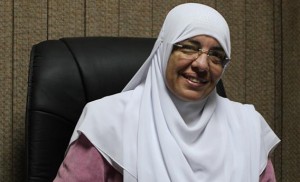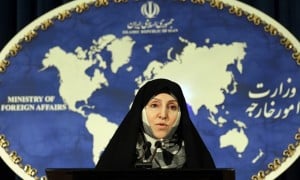Slate recently ran a piece about Azza al Garf, dubbing her a “culturally regressive trailblazer,” and likening her to well-known American female conservatives such as Michele Bachman and Sarah Palin. Azza al Garf, a female member of the Muslim Brotherhood’s Freedom and Justice Party who was recently elected to the post-revolutionary Egyptian Parliament, had not been coy about her intentions should she win a seat in the new Parliament.

As reported earlier by Egypt Independent, Azza al Garf claimed that if she won, she would work toward reversing “women’s and children’s laws that were promulgated in the defunct [Mubarak] epoch and violate Islamic Sharia and human nature.”
This is disconcerting, as some of the “women’s and children’s laws” publicized during Mubarak’s time are, for example, laws that give women the right to divorce, that criminalize female circumcision, and that give women the right to register their children even if the father is unknown. Whether al Garf was referring to these laws or not remains to be seen.
While there is legitimacy in the doubts Slate author Nina Burleigh raises, as to whether a conservative female Member of Parliament can mirror the changes which Egyptian women hope to see from the new government, her approach is all wrong.
Instead of writing an insightful article on what Azza al Garf’s election to Parliament means or might mean for women’s rights in Egypt, she instead resorts to making stereotypical deductions and drawing subjective parallels between al Garf and her supposed Western “counterparts”.
The first of such grossly derisive comments is made in Burleigh’s first paragraph when she describes the men of the Muslim Brotherhood Party as having “protuberant prayer calluses on their foreheads resembling large warts.” Such abrasive sentiments show Burleigh’s true colors—an attitude of intolerance and disregard for others’ religious practices. Not to mention painting the hackneyed picture of “scary” Muslim men.
The article goes on to call al Garf, and other women members of the party, “oxymoronic creatures: culturally regressive trailblazers.” How exactly these women are “culturally regressive” and whose culture Burleigh is referring to is not made clear. Burleigh does not point out specific policies that al Garf endorses that may drive the struggle for women’s rights in Egypt into a backsliding motion, but instead draws parallels between al Garf and American female conservatives like Bachman and Palin to illustrate that al Garf is a “culturally regressive trailblazer.”
What do these women have in common? According to Burleigh, it is their religiosity tjat puts these women in a state of “regression.” Burleigh states that for al Garf “religiosity is a full immersion that permeates every aspect of life” and she readily relies on supernatural guidance in political involvements. Burleigh implies that religiosity is incompatible with concepts of justice, equality, and even feminism, pigeonholing all women who are “conservative” or “religious” as those who would be likely to not “support policies that would actually improve the real lives of women.”
Burleigh seems to forget that there are in fact Egyptian women and Muslim women, some of which identify as feminists, who fight to progress women’s rights yet, would still consider their religion to permeate every aspect of their life, including informing those very struggles for equality and justice.
Interestingly enough, Burleigh is a bit of an oxymoronic theorist herself. While she seemingly blames al Garf’s chosen religiosity as the common denominator in regressive ideals regarding women’s rights, she also expresses the opinion that this position of “regression” is, contrariwise, imposed by Muslim men. This is indicated by Burleigh’s statement that, “al Garf and her ilk dare not crow about it,” referring to their “second-place” status within the Freedom and Justice Party, which prevents them from voting for party leaders or serving on top committees. Her description of Egypt’s women as “swaddled in scarves and floor-length gowns—the restrictive costume a direct result of decades of social pressure from the Muslim Brotherhood,” also suggests their religiosity and “regression” is enforced by men.
So which is it? Is it the “scary” men imposing regressive sanctions on women and women’s rights? Or is it the religion that these women choose to follow that is inherently degenerating to women’s rights?
Either recycled argument Burleigh is propagating is an ancient reverberation in the ears of Muslim women. Burleigh does nothing to tell readers exactly which ideas of Azza al Garf show her “unabashed commitment to policies that limit or reverse women’s rights.” Nor did she do anything in the way of furthering the conversation with al Garf on issues such as abortion or female circumcision.
An insightful conversation on these issues, rather than drawn out overgeneralizations about the supposed parallels between “Western” and “Eastern” female conservatives would have given readers a chance to examine how al Garf and other women elected to Egypt’s new Parliament might change the sociopolitical landscape for women’s rights in Egypt. Burleigh instead gave us the timeworn stereotypes we have grown so weary of hearing.
Thank you Nina Burleigh for playing the entitled and pedestrian role of speculation, saving neither nuance nor articulation, wavering between “saving” and Islamophobic rhetoric, and flirting with intolerance.











